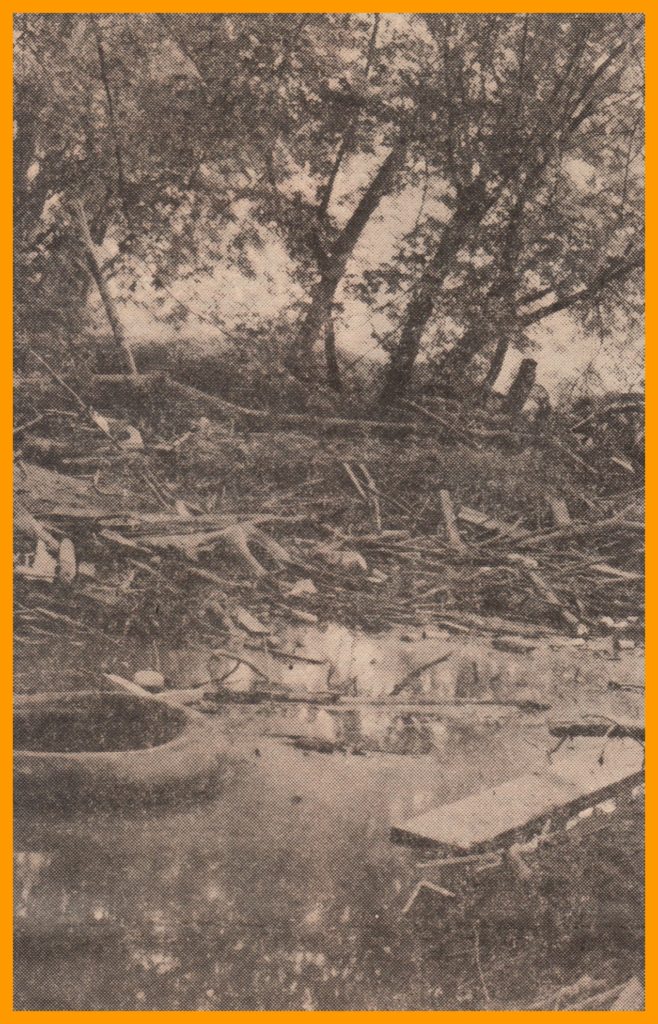Two photos and a news article that appeared in the Harrisburg Patriot, June 30, 1976, about Federal funds that were made available to restore streams in the Upper Dauphin County area that were damaged by Tropical Storms Agnes and Eloise.
Caption for above photo:
Dam Created by Flood Debris
Debris washed down Shippy Dam Creek in floods resulting from Tropical Storms Agnes and Eloise accumulates to form a dam on the farm of Roger Seltzer of Millersburg. Federal money just released by Congress is being used to restore other area streams damaged by the floods.
_______________________________________
Sluice Gate Checked
George Luther of Loyalton checks a nearly completed sluice gate that will provide some flood protection from the Wiconisco Creek in the eve2nt of high water. The rear of the Luther residence was destroyed in the 1972 flood.
__________________________________________
FUNDS TO WASH AWAY DEBRIS
by Rick Drake, Patriot Correspondent
It seems as if the cleanup from Tropical Storms Agnes and Eloise will never end.
“Both of the hurricanes have put a scare into people,” said Paul O. Swartz, executive assistant, Dauphin County Conservation District.
He and his office will use $95,000 that has been released by Congress to restore streams damaged by Eloise.”
Although Swartz doesn’t expect work to begin until about August 1, flood-damaged waterways in the county are being assessed.
Wiconisco Creek in upper Dauphin County is the first to be scheduled for refurbishment. Along with the Wiconisco, Deep Creek, a tributary of Mahantango Creek, is an opening target. After those, Armstrong and Powell’s Creeks to the south will flood.
Swartz predicts the funds will cover work on all four restoration sites. Should money still be available, the next stop would be Shippy Dam Creek in Millersburg, then Manada, Beaver and Conewago creeks.
Stream restoration is not a new concept to the Susquehanna Valley. Powell’s Creek was cleaned up after Agnes struct in 1972.
However, this type of work is generally not well known. Swartz explained that the purpose is four-fold. Debris dams that have accumulated during floods, and when left standing, pose serious drainage problems, will be removed. Dams promote bank erosion, a second problem.
To correct bank erosion, especially in spots where the water makes a sweeping bend, large rocks called “rip-rap” are placed against the banks. Soil and vegetation, such as crown vetch, are placed stop the rocks to anchor the bank.
Isolated trees that have fallen across a stream also must be cut and dragged clear. Finally, the least of the conservationists’ worries are gravel bars that trap silt behind and on them, thereby slowing the stream.
Restoration may be necessary after a big storm, but Swartz takes a preventative approach. Since 1952, when the Dauphin County Conservation District was established, the purpose has been to help farmers keep soil on their land, according to Swartz.
Even today the emphasis is to get farmers and developers to guard against silt and erosion problems.
“We have been rapidly urbanizing areas, compounding natural problems,” Swartz said. To aid the county landowners, his office offers a “Conservation Plan” as a result of studies of soil types, crops, slope of the land, and peculiar drainage problems. There is no charge for this service.
The stream restoration is being cosponsored by the Dauphin County Conservation District, Dauphin County, and municipalities involved. Contracts for all work will be awarded to the lowest bidder. The work itself will be supervised by the Dauphin County Soil Conservation Service, a federal agency.
“There are some people who won’t want the work done, and I respect that,” Swartz said, adding that all stream work is voluntary. Care will be taken to protect wildlife and repair land that may have been damaged, he said.
To Swartz, it is important that officials “get in touch with all the people involved” in a project, like Roger Seltzer, whose Millersburg farm is divided by Shippy Dam Creek.
Seltzer recalls the day when he watched muskellunge and carp swim swim in from the Susquehanna to spawn. Now it’s impossible for any fish to swim into the creek that runs through his land. Debris dams provide an unnatural barricade. Backed-up water has melted away the bank near the dam.
In nearby Loyalton, George Luther and Elizabeth Luther have decided to place the burden on the county. “We’ve done our part. Now we want the government to do its part,” said George Luther, an inhabitant of old “Fisher’s Mill.” He spoke of Wiconisco Creek, where a mill race paralleling the creek was cleared. A week’s worth of back-hoeing and bulldozing opened a trench six feet wide and four feet deep to alleviate high water run-off.
The flood of 1972 destroyed the back of the Luther house. With landfill from the trench and additional dirt from an island upstream that the government agreed to remove, Luther said he expects to have plenty of protection on his side for a while.
Swaratz said that funds for the project became available through the federal flood prevention act of 1950.
A sum of $3 million has been set aside to help 24 counties in or near the Susquehanna Valley with similar projects.
______________________________________
Corrections and additional information should be added as comments to this post.

